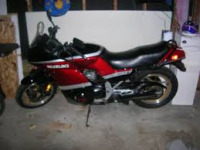HolyRoller
Been Around the Block
So, painting a full set of plastic fairings on my 84 gs750ef.
Did a LOT of prep work over the winter, so that is not an issue. However, when I finally got the shop warm enough, I put some clear plastic sheets, set up a decent fan (sucking air out of the "booth") and bought paint. The plan is to paint a base coat of black, with some red and silver sections on top of the black. Couple of questions now that I have actually attempted to paint the black base coat....
1. I have a couple of runs in a couple of places. The paint gun was new and I thought I had it setup properly, but evidently not. I also think I may have been a little heavy on the third coat. Additionally, while I was painting, somehow, a few drops of black paint seemed to come out of the top of my gravity reservoir and landed on two of the pieces already sprayed. That was not cool. So, few small runs, few drops of black paint. Otherwise, really looks good. I haven't sprayed clear yet.
2. With the above in mind... can I wet sand the base coat (runs and drops), re-spray those areas, and use some mineral oil or other degreaser and move on to clear? Since by now, the base I have sprayed will be pretty dry... is this a major problem? Will I have to scuff the base at this point before spraying clear?
3. As I am going to be masking the black base and spraying a fair amount of red and a small amount of silver... should I mask straight over the black? Should I scuff the black before masking and painting the other colours? After the red and silver are completed... do I scuff the whole thing before spraying clear?
I am quite inexperienced but determined to learn this and do it myself... even if I make mistakes. I would really appreciate any advice. The mistakes I made spraying the base coat (runs) are likely significant enough that a thick coating of clear and sanding will not cover it up. I need to fix the base coat.... and need some advice.
Thanks in advance for any info.
I will look through the threads to see what I can find, but am too exhausted to spend too much time searching.. I hope someone here has some sage advice.
Did a LOT of prep work over the winter, so that is not an issue. However, when I finally got the shop warm enough, I put some clear plastic sheets, set up a decent fan (sucking air out of the "booth") and bought paint. The plan is to paint a base coat of black, with some red and silver sections on top of the black. Couple of questions now that I have actually attempted to paint the black base coat....
1. I have a couple of runs in a couple of places. The paint gun was new and I thought I had it setup properly, but evidently not. I also think I may have been a little heavy on the third coat. Additionally, while I was painting, somehow, a few drops of black paint seemed to come out of the top of my gravity reservoir and landed on two of the pieces already sprayed. That was not cool. So, few small runs, few drops of black paint. Otherwise, really looks good. I haven't sprayed clear yet.
2. With the above in mind... can I wet sand the base coat (runs and drops), re-spray those areas, and use some mineral oil or other degreaser and move on to clear? Since by now, the base I have sprayed will be pretty dry... is this a major problem? Will I have to scuff the base at this point before spraying clear?
3. As I am going to be masking the black base and spraying a fair amount of red and a small amount of silver... should I mask straight over the black? Should I scuff the black before masking and painting the other colours? After the red and silver are completed... do I scuff the whole thing before spraying clear?
I am quite inexperienced but determined to learn this and do it myself... even if I make mistakes. I would really appreciate any advice. The mistakes I made spraying the base coat (runs) are likely significant enough that a thick coating of clear and sanding will not cover it up. I need to fix the base coat.... and need some advice.
Thanks in advance for any info.
I will look through the threads to see what I can find, but am too exhausted to spend too much time searching.. I hope someone here has some sage advice.





